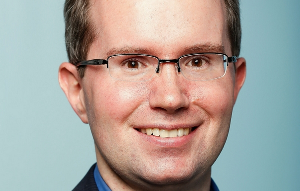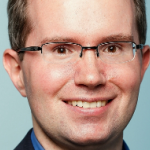In 2015 and again in May 2017, the United States Federal Communications Commission was recognized as a recipient of the global CIO 100 awards, an honor often reserved for Fortune 500 companies for their work in using technology to transform how they operate. The FCC is the only public sector organization to receive the honor twice.
For the last three-and-a-half years, Dr. David Bray has served as senior executive and CIO. Given this double-honor of the CIO 100 awards, who better than Dr. Bray to chair a working group organized to champion the use of cloud services in the public sector. In 2015, Dr. Bray and his team completed an extensive overhaul of the FCC’s then 207 legacy systems and migration to the cloud, and he’s since been a vocal advocate for a cloud-first approach across public service agencies.
Now, Dr. Bray is tapping into his experiences to lead and organize an inter-agency group called the Federal Cloud Center of Excellence. We caught up with him to learn more about the goals of the working group and the benefits he hopes cloud services will bring to the public sector.

The Enterprisers Project (TEP): Can you tell us what the Federal Cloud Center of Excellence is and your role in the working group?
 Dr. Bray: Recently, I was approached by the U.S. General Services Administration (GSA), an organization that oversees acquisition for everything from pens and desks to building leases for government facilities. This also includes IT hardware and software. They wanted me to chair an interagency working group called the Federal Cloud Center of Excellence (CCOE) and help quell some of the myths and pushback associated with moving to the cloud. Since the FCC has already made a massive transformation to 100 percent public cloud and commercial service provider, we could help dispel “cloud myths” that this was too hard, or not possible to do with speed. So I gladly accepted the offer.
Dr. Bray: Recently, I was approached by the U.S. General Services Administration (GSA), an organization that oversees acquisition for everything from pens and desks to building leases for government facilities. This also includes IT hardware and software. They wanted me to chair an interagency working group called the Federal Cloud Center of Excellence (CCOE) and help quell some of the myths and pushback associated with moving to the cloud. Since the FCC has already made a massive transformation to 100 percent public cloud and commercial service provider, we could help dispel “cloud myths” that this was too hard, or not possible to do with speed. So I gladly accepted the offer.
The primary goal of the CCOE is to identify the barriers standing in the way of public service adopting more commercial cloud solutions. My first act as chair was to ask stakeholders why they thought retiring legacy IT and embracing commercial cloud solutions would actually matter to a member of the public. Why should the public care? I also asked why would it matter to the head of the department or agency embarking on this shift to cloud – why would they care?
FCC’s transition to the cloud showed that it is possible to move to the cloud with speed. Back in late 2013, we were spending 85 percent of our budget just to maintain 10-year old legacy systems. However, after a dramatic shift to public cloud and commercial service provider, we saw our maintenance spend drop down to less than 50 percent of our budget. Instead of taking six or seven months to stand up a new IT prototype, we can now develop a working prototype in less than 48 hours by reusing one of our existing cloud platforms. In addition, we have added resiliency that comes from our cloud providers.
With the CCOE, I also shared our challenges when it comes to budgeting for this type of transformation. Most of the federal government operates on three-year budget cycles, which makes it very challenging to plan for future investments with agility and flexibility to adopt new technologies as they emerge. There’s another requirement of the federal government, which is you cannot buy something unless you have all the money necessary for the contract up front. As a result, auto-renew licenses for cloud services are challenging to sell to public service.
With some intense budget skills and proper planning, it is possible to digitally transform with speed despite these constraints – it just requires a really good team. At the FCC, we couldn’t have made our transformation without the impressive skills of Associate CIO Georgette Sumpter, who made sure we made the maximum use of our “fuel” available to adopt cloud solutions quickly.
TEP: What are the primary goals and objectives of the CCOE?
Dr. Bray: We wanted to address five key areas to make it easier for agencies to make the leap to the cloud: Acquisition, Education, Security, Advocacy, and Pricing. I’ll briefly summarize the goals of each.
- Acquisition. Each separate government agency shouldn’t have to do their own individual contract for a commercial cloud service when that service is something that every agency will need. We need to make it easier to acquire commercial cloud services by having one or two agencies pre-negotiate with vendors, address challenges, and communicate learnings to the larger landscape of the public service workforce.
- Education. If you go to your team and say, “I know you’re used to patching servers and maintaining them on premise, but now we’re going to a commercial cloud and you won’t need to do that any longer” - your workforce might become highly concerned about what job they will have in the future. We need to proactively educate employees about what they’ll do post-cloud adoption and help agencies retrain for the skills necessary for the decade ahead. This helps make digital transformation less scary.
- Security. The public sector is often a target for breaches because several departments have information related to people, market activities, law enforcement efforts, and more. If we are working with the commercial sector on cloud solutions, we need consistency “baked-in” from the start around security features. The purpose of the CCOE is to develop a consistent set of security controls and plans to ensure resilient cybersecurity standards across agencies.
- Advocacy. Transformation requires everyone in the organization to be on-board with change – as part of a shared endeavor. So if the government is going to follow what FCC did and adopt public cloud and commercial service offerings with speed, we’ll need to enable both the private and public sectors to do what they do best while also allowing the public to weigh in, too. It shouldn’t just be a government endeavor. We also need inputs from members of the public and the commercial sector around the latest advances in cloud technology.
- Pricing. Right now, most public sector service agencies are doing their own unique, custom-tailored HR, their own finance systems, etc. If there were pre-negotiated a la carte commercial cloud shared services, agencies could more easily purchase cloud without having to do their own time-consuming acquisition. That way, if an agency wanted to replace your aging, 15-year-old HR system currently being done on premise, there would ideally be a set of existing cloud service options. Agencies could pay for a cloud service without the need to create a new contract or the barriers of developing a custom-tailored solution from scratch, making it easier to move toward the cloud.
TEP: Why is there a major push for cloud? What do you see as the primary benefits for the public and heads of agencies?
Dr. Bray: Cloud services are enabling agencies and organizations to reinvent their processes and how they deliver results and outcomes through public service. Packet latency between Topeka, KS and Washington, DC is no longer four days on horseback – it’s now milliseconds. The public can interact and provide input into public service directly with speed. Local, state, and national government agencies all have to move off of legacy IT for the benefit of public and private sector stakeholders. Agility, resiliency, and reduced maintenance are the top three benefits.
Digital transformation also represents a chance for the heads of organizations or agencies, and ultimately the public, to simplify, streamline, and evolve the processes of doing public-sector work. Legacy IT ossifies your business processes and makes it impossible to move with speed. Cloud services, done correctly, allow you to be more streamlined and nimble in your processes and provide better service for your public stakeholders.
TEP: The FCC has won the global CIO 100 awards in 2015 and again in 2017, a rare double-honor for a public service organization. To what do you attribute this?
Dr. Bray: A group of determined, focused, positive change agents – plain and simple. By change agents, I mean a committed group of folks at all levels in the organization willing to step beyond the status quo and have strategies for how to manage the friction of doing so. Lots of change efforts attempt to challenge the status quo, yet few have a strategy for how to make sure they are not just “heat and light” with no forward movement. Positive change agents avoid shiny, superficial efforts and focus on substantive, meaningful change that advances the organization forward.
Leaders need to recognize that any type of major change, especially digital transformation, requires focused attention to obtain buy-in from all levels of an organization for meaningful change to occur. Digital transformation requires folks to adopt the mindset of a creative problem solver, willing to practice organizational empathy and identify solutions to challenges, adapt, overcome, and most importantly deliver results that matter. I consider myself extremely fortunate because every day I am inspired by positive change agents and the opportunity to work alongside them.





Comments
This is a great way for other organizations to adopt cloud services with speed. FCC has done a great job and other agencies can too. Thank you!
congrats on the second cio100 award. also love this statement on the power of change agents:
a committed group of folks at all levels in the organization willing to step beyond the status quo and have strategies for how to manage the friction of doing so.